
A review of nature-based systems to treat blueberry irrigation runoff
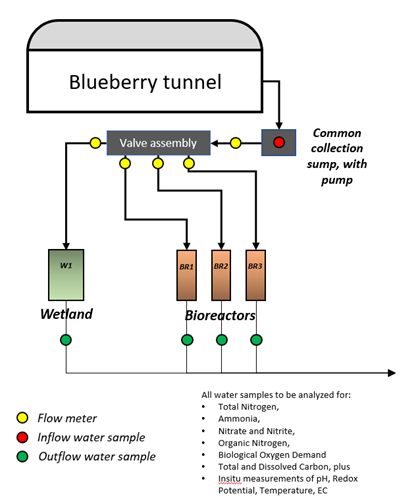
Dr Mark Bayley (Mark Bayley Consulting)
Diana Unsworth, David Cordina, David Mitchell and Melinda Simpson (NSW Dept of Primary Industries)
The Clean Coastal Catchments (CCC) Research project is assessing the effectiveness of nature-based systems for the removal of nitrogen from crop irrigation run off at the Wollongbar Primary Industries Institute.
The two most adopted nature-based technologies for reducing nitrogen levels from wastewater are constructed wetlands (reed beds) and denitrification bioreactors (wood chip bioreactors). In this trial, three bioreactors and one reed bed were installed at the Wollongbar Blueberry Nutrition Research Facility to treat nutrient rich run off from 300 potted blueberry plants.
The project adopted common design and operational elements from existing denitrifying bioreactors and reed beds within Australia and across the world. Once installed the efficacy of the bioreactors and the reed bed to reduce nitrogen (volume and quality) in the irrigation run off water was measured. The aim is to provide basic design and construction schematics for the bioreactors and reed bed, that can be supplied to growers in intensive horticulture industries who are interested in incorporating this technology, appropriately scaled, into their farming systems.
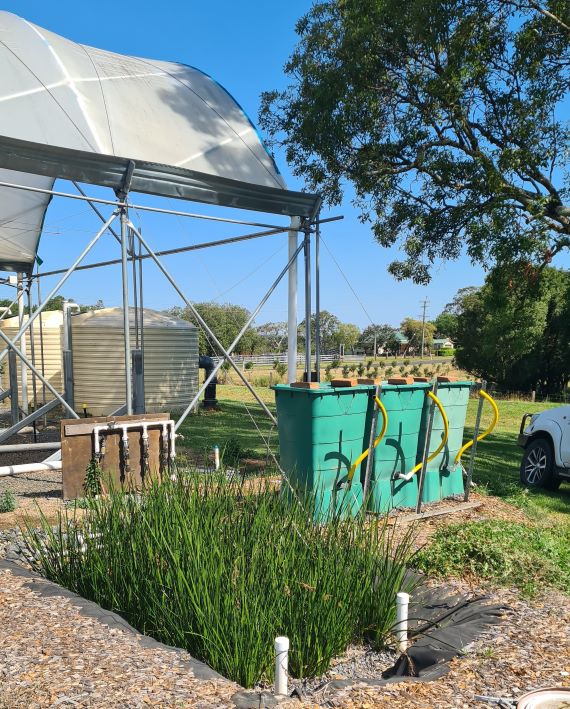
Background
Nitrate applied as fertiliser, either before planting or during crop production, is highly mobile and leaches easily from shallow soil layers to lower soil layers. In areas with shallow groundwater this can result in the nitrate entering the local groundwater system. Additionally, the mobility of nitrate means that in some cases surface run off water can contain a significant amount of nitrate which can cause negative off farm impacts.
Bioreactors and wetlands create the required conditions for the rapid conversion of water soluble nitrates into the gas dinitrogen (N2), providing a viable method for reducing excess nitrogen in water flowing from intensive horticultural operations, including hydroponic fertigation systems. This occurs via the relatively simple heterotrophic microbial mediated ‘denitrification’ reaction (Kadlec, 2009), which converts water soluble nitrate to dinitrogen gas (N2). However, it is important to get the conditions right, such as sufficient capacity to meet minimum retention times (based on the flow rate and nitrogen concentration of the irrigation run off), for this technology to be effective and efficient.
Experimental Design
Irrigation run off water is collected from the substrate blueberry drain system into a common collection sump (~200L), prior to being dosed to either the bioreactor trial or the reed bed trial.
A Sampling schematic is shown in Figure 1, while the actual setup is pictured in Figure 2.
One of the benefits of using a bioreactor is that the reduction of nitrate in agricultural run off water occurs in a relatively short time frame following construction. Reed beds, on the other hand, require more time (12-18 months) before their optimum denitrification potential is achieved. This trial commenced with the bioreactors in operation, whereas the reed bed was not initially at full capacity, and it took some time for the reed bed to progress through a ‘maturation phase’.
Trial methods and interim results
Flow Monitoring
The flow of irrigation run off water into each of the bioreactors and the reedbed is measured using a 25 mm inline flow meter. Manual readings are taken on the day of water sample collection.
A water-level sensor is located within the irrigation collection sump, with the water level being logged every 2.5 mins. This logger counts the number of pump cycles delivered to the treatment systems, enabling an overall daily flow rate to be calculated.
Water quality monitoring
Water samples were collected from the common inlet and each outlet of the reedbed, and the three bioreactors on three days a week of each of the respective sampling periods, and then analysed for the analytes listed in Table 1.
Table 1:
Water sampling analytes |
Total Nitrogen (TN) |
Ammonium |
Nitrate + Nitrite |
Total Phosphorus |
Free reactive phosphorus |
Dissolved Organic Carbon |
Total organic carbon |
pH |
Temperature |
Conductivity |
Dissolved oxygen |
Redox potential |
Interim results
Bioreactors
Initially, the amount of irrigation run off flowing into to the bioreactors was variable, resulting in irregular flows for the first 3 sampling dates, ranging from ~250 L/day to 15 L/day, resulting in a mixture of hydraulic retention times for the irrigation water within the bioreactors. This situation stabilised by mid-August 2023, by which time the average flow to the bioreactors was 42.35 L/day with a standard deviation of 6.39.
Figure 3 and Figure 4 show that once the flow rates stabilised, nitrate removal across all three bioreactors was extremely high, with removal efficiencies exceeding 95% across this time series.
While there was an overall Total Nitrogen (TN) reduction within the bioreactors, ammonium (NH4-N) increased in all reactors in comparison to the sump in the last six sampling events. This is most likely the result of Dissimilatory Nitrate Reduction (DNRA) – where nitrate is reduced to ammonium by obligate anaerobes in low oxygen conditions (Redox Potentials below 0 mV) (Reddy and DeLaune, 2008). Redox Potential reduced to less than 0mV by the 18th of August, which corresponds to the increase in ammonium in that sampling event and all subsequent events (Figure 4). Denitrification is a more conservative, energy efficient molecular pathway for nitrate loss (Reddy and DeLaune, 2008), therefore while some DNRA may be observed, denitrification is expected to remain the dominant pathway for nitrate loss within the bioreactors.

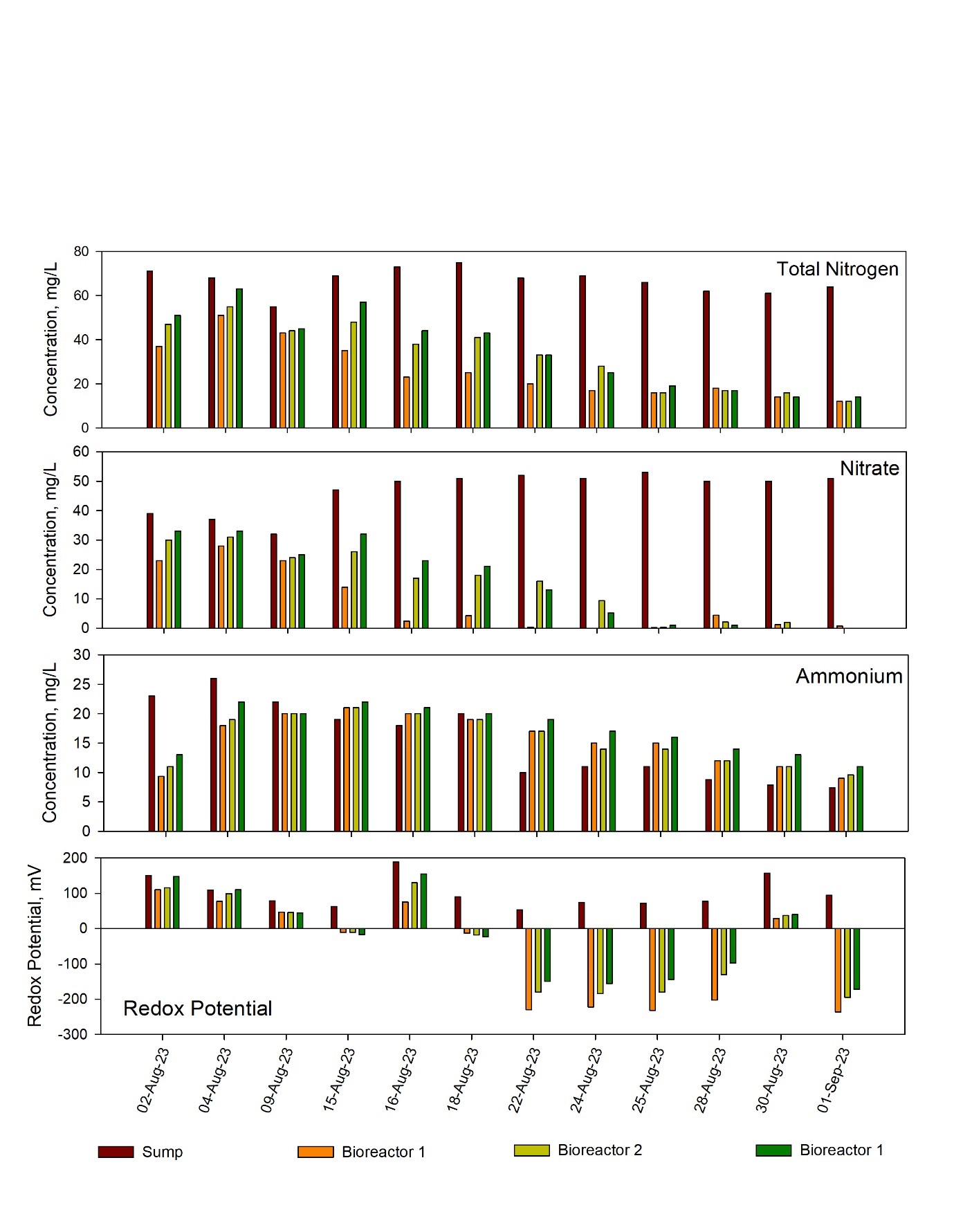
Reed bed
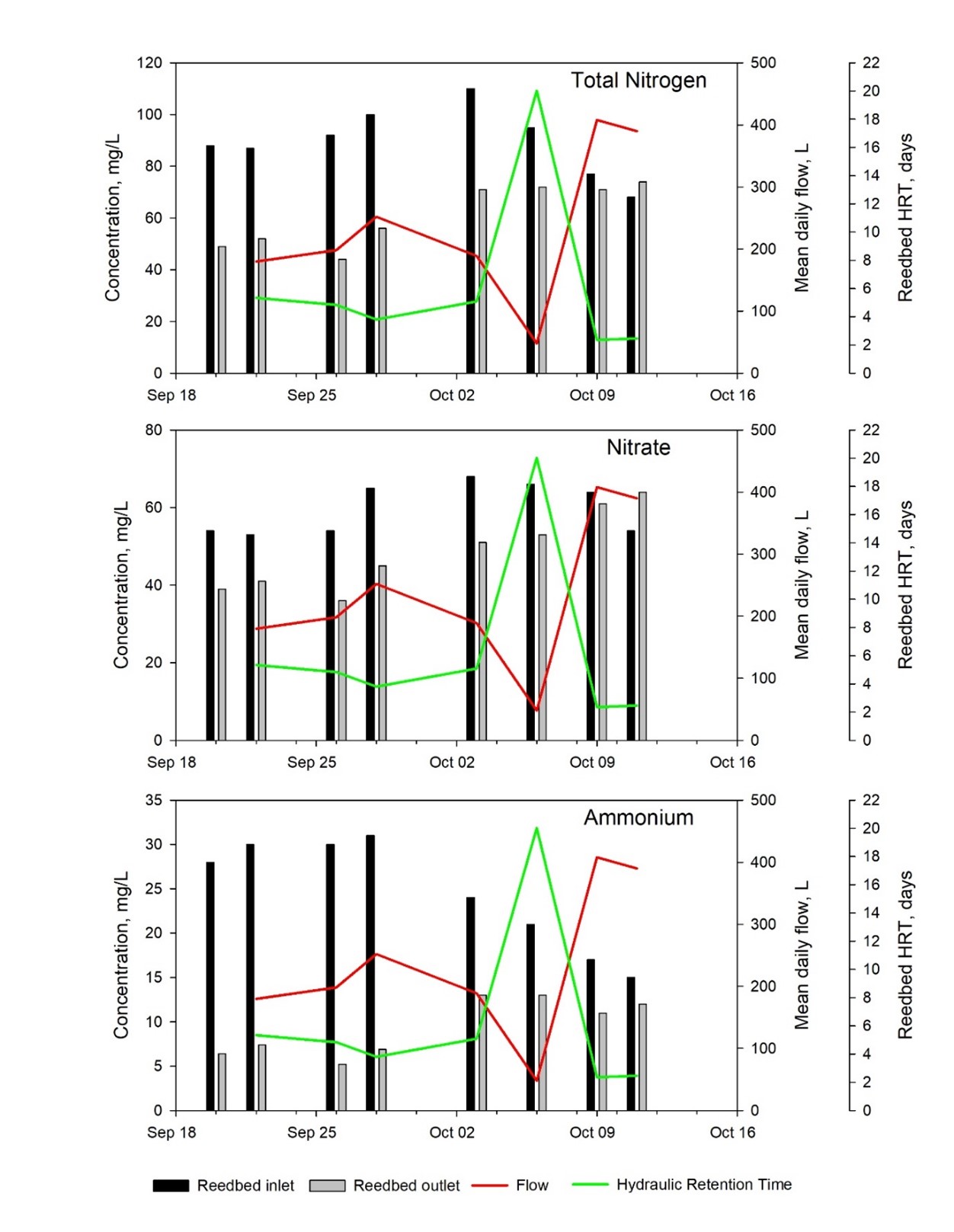
Reed bed monitoring data was collected for the period from 20 September 2023 to 16 October 2023 and water quality results from the reed bed trial for both nitrogen and phosphorus ionic species were measured (Figure 5, Figure 6). The irrigation run off delivered to the reed bed was around 200 litres per day at the beginning of the sampling period, and then after dropping to around 50 litres per day, increased to around 400 litres per day for the final two sampling events (red line Figure 5, Figure 6). Increased flow results in a reduced amount of time are held within the reed bed (HRT) and hence a reduced treatment time, shown as the green line (Figure 5, Figure 6).
Total nitrogen loss across the sampling period averaged ~40% removal under a Hydraulic Retention Time (HRT) of approximately 4 days, with the exception of the last two monitoring rounds in which the flow to the reed bed significantly increased and the HRT of the reed bed reduced to around 2 days (Figure 5, Figure 6). Removal of NO3-N averaged around ~25%, with NH4-N reduction approximately ~66% across the sampling period (ignoring the last two sampling regimes in which there was excessive flow through the reed bed).
Phosphorus removal within the reed bed was high, at ~41%, however this is not expected to persist as one of the main mechanisms for phosphorus removal within reed beds is the adsorption of PO4-P onto the surface of the substrate. It is expected that over time phosphorus reduction will decrease and be limited to that which is taken up by the plant and microbial community.
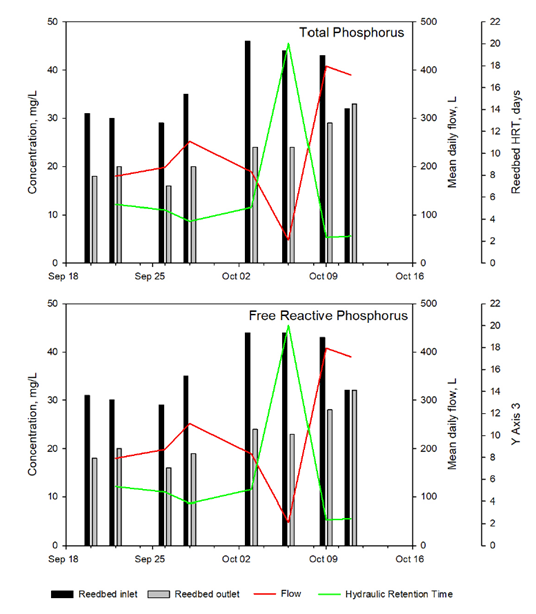
Conclusions and recommendations
The bioreactors have shown excellent nitrate reduction, based on the water quality data observed during the sampling (Spring 2023) season. Continued monitoring may show that increased irrigation rates through the warmer months result in higher hydraulic loading and potentially lower nitrate removal rates. However, at this stage, there appears to be sufficient capacity within the bioreactors suggesting no major changes to the experimental design will be required. Once this is determined, design parameters can be confirmed and scalable solutions for intensive horticulture can be specified.
The reed bed also demonstrated effective nitrogen reduction where the hydraulic retention time was at least 4-5 days. When Nitrogen is in high concentrations (>80 mg/L), the data suggests that there is a rapid reduction in nitrogen within the first 4-5 days, however this rate of loss appears to slow significantly as the HRT increases. As inflow increased and HRT dropped below 2.5 days, significantly less nitrogen reduction occurred. This suggests that the reed bed is best suited to cater for the largest anticipated inflows targeting an HRT of at least 4-5 days. Further monitoring of the reed bed will help quantify and explain these observations.
While a significant reduction in phosphorus levels was observed, this was attributed to absorption onto the surface of the new substrate. As the reed bed matures, absorption by the substrate is expected to decrease and phosphorus loss will be limited to that which is taken up by the plant and microbial communities.
This Clean Coastal Catchments project research was funded by the NSW Government under the Marine Estate Management Strategy.
The ten-year Strategy was developed by the NSW Marine Estate Management Authority to coordinate the management of the marine estate.
This article was originally compiled for publication in the Autumn 2024 edition of the Australian Berry Journal.

